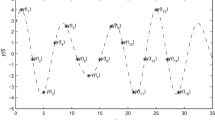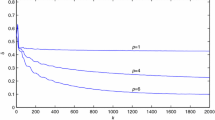Abstract
This work presents the uncertainty analysis of an artificial neural network (ANN)-based method, called multiharmonic ANN fitting method (MANNFM), which is able to obtain, at a metrological level, the spectrum of asynchronously sampled periodical signals. For sinusoidal and harmonic content signals, jitter and quantization noise contributions to uncertainty are considered in order to obtain amplitude and phase uncertainties using Monte Carlo method. The analysis performed identifies also both contributions to uncertainty for different parameters laboratory configurations. The analysis is performed simultaneously with our method and two others: discrete Fourier transform (DFT), for synchronously sampled signals, and multiharmonic sine-fitting method (MSFM), for asynchronously sampled signals, in order to compare them in terms of uncertainty. Regarding asynchronous methods, results show that MANNFM provides the same uncertainties than MSFM, with the advantage of a simpler implementation. Regarding asynchronous and synchronous methods comparison, results for sinusoidal signals show that MANNFM has the same uncertainty as DFT for amplitude and higher uncertainty for phase values; for signals with harmonic content, amplitude conclusions maintain but, regarding phase, both MANNFM and DFT uncertainties become closer as the frequency increases, which implies, in fact, that when synchronous sampling is not possible, spectrum analysis can be performed with asynchronous methods without incurring in uncertainty increases.












Similar content being viewed by others
Notes
The error of synchronism is due to the differences between generation and sampling time bases. Authors’ expertise (with real and simulated signals) has shown that this error affects only the convergence of the method to global or local minima, but not to the value of these minima. So, it will not be considered an uncertainty source. Nevertheless, it has been included in simulations just to perform the uncertainty evaluation in the more general conditions.
Brand names are used for purpose of identification. Such use does not imply endorsement by authors or assume that the equipment is the best available.
Only in the case of amplitude considering exclusively jitter, for both signals, very similar behaviours are appreciated. In the rest of the cases (included phase deviations considering exclusively jitter), different behaviours are observed.
For example, for amplitude standard deviation, supposing a starting point of 21 bits and 1311 samples and a resolution reduction from 21 to 18 bits, it can be mostly compensated if N = 15,457 is fixed. Nevertheless, if, in the same starting point, the reduction is from 21 to 16 bits, the uncertainty obtained with 16 bits at 15,457 samples is one order of magnitude higher than the initial one.
References
Svensson S (1999) Power measurement techniques for nonsinusoidal conditions. Doctoral Thesis, Chalmers University of Technology, Sweden
Wright PS (1994) Traceability in power/reactive power measurements and assessment tests for ‘IEC555 power analyzers’, using the NPL Mk.III digital sampling wattmeter. IEE Colloquium on Low Frequency Power Measurement and Analysis (Digest No. 1994/203), pp. 1/1–1/6
Oppenheim AV, Schafer RW (1999) Discrete-time signal processing. Prentice-Hall, Upper Saddle River
Pogliano U (2001) Use of integrative analog-to-digital converters for high-precision measurement of electrical power. IEEE Trans Instrum Meas 50(5):1315–1318
Salinas JR, Lagos FG, Joya G, Sandoval F (2006) New Spanish electrical power standard. In: MELECON 2006—2006 IEEE Mediterranean electrotechnical conference, Malaga, Spain, pp 994–997
IEEE standard 1241, 2010 (2010) Waveform Measurement and Analysis Technical committee, IEEE Standard for Terminology and Test Methods for Analog-to-Digital Converters
Ramos PM, Cruz Serra A (2007) Least squares multiharmonic fitting: convergence improvements. IEEE Transactions on Instrumentation and Measurement 56(4):1412–1418
Salinas JR, García-Lagos F, Joya G, Sandoval F (2009) Sine fitting multiharmonic algorithms implemented by artificial neural networks. Neurocomputing 72(16–18):3640–3648
Salinas JR, Lagos FG, Romero ML, Joya G, Raso F, Neira M, Sandoval F (2006) Versatile digital system for high accuracy power measurements. In: Conference on precision electromagnetic measurements (CPEM 2006), pp 98–99
Salinas JR, Díaz de Aguilar J, García-Lagos F, Joya G, Sandoval F, Romero ML (2014) Spectrum analysis of asynchronously sampled signals by means of an ANN method. In: Conference on precision electromagnetic measurements (CPEM 2014), pp 422–423
Salinas JR, García-Lagos F, de Aguilar JD, Joya G, Lapuh R, Sandoval F (2016) Harmonics and interharmonics spectral analysis by ANN. In: 2016 conference on precision electromagnetic measurements (CPEM 2016), Ottawa, Canada, pp 1–2
Salinas JR, García-Lagos F, de Aguilar JD, Joya G, Sandoval F (2017) Uncertainty analysis of ANN-based spectral analysis using monte carlo method. In: Rojas I, Joya G, Catala A (eds) Advances in computational intelligence, IWANN 2017, Lecture Notes in Computer Science, vol 10305. Springer, Cham, pp 269–280
JGCM 100:2008. Evaluation of measurement data –Guide to the expression of uncertainty in measurement
JGCM 101:2008. Evaluation of measurement data—Supplement 1 to the “Guide to the expression of uncertainty in measurement”—Propagation of distributions using a Monte Carlo method
JGCM 102:2011. Evaluation of measurement data—Supplement 2 to the “Guide to the expression of uncertainty in measurement”—Extension to any number of output quantities
Šíra M, Mašláň S (2014) Uncertainty analysis of non-coherent sampling phase meter with four parameter sine wave fitting by means of Monte Carlo. In: 29th conference on precision electromagnetic measurements (CPEM 2014), Rio de Janeiro, pp 334–335
Wadgy MF (1987) Effects of ADC quantization errors on some periodic signal measurements. IEEE Trans Instrum Meas 36(4):983–988
Wagdy MF, Awad SS (1990) Effect of sampling jitter on some sine wave measurements. IEEE Trans Instrum Meas 39(1):86–89
Jain VK, Collins WL, Davis DC (1979) High-accuracy analog measurements via interpolated FFT. IEEE Trans Instrum Meas 28(2):113–122
EN 50470-3:2006. Electricity metering equipment (a.c.)—Part 3: particular requirements—static meters for active energy (class indexes A, B and C)
Acknowledgements
This work was partially supported by the Universidad de Malaga - Campus de Excelencia Andalucia-Tech.
Author information
Authors and Affiliations
Corresponding author
Ethics declarations
Conflict of interest
The authors declare that they have no conflict of interest.
Additional information
Publisher's Note
Springer Nature remains neutral with regard to jurisdictional claims in published maps and institutional affiliations.
Appendices
Appendix 1
Tables 10 and 11 show standard deviation results obtained for amplitude and phase of half-wave rectified harmonics for the case of a jitter value of 100 ns and 16 bits of quantization, 15,457 samples and different R values. In order to unify data as much as possible, both tables simultaneously present values obtained considering only jitter (j) and only quantization (q).
Appendix 2
Tables 12 and 13 show standard deviation results obtained for amplitude and phase of half-wave rectified harmonics for the case of a jitter value of 100 ns and 16 bits of quantization, R fixed to 24 and different N values. In order to unify data as much as possible, both tables simultaneously present values obtained considering only jitter (j) and only quantization (q).
Appendix 3
Tables 14 and 15 show standard deviation results obtained for amplitude and phase of half-wave rectified harmonics for the case of a jitter value of 100 ns, R fixed to 24, different N values and different number of bits. Due to the amount of data to be included, values obtained considering only jitter (j) are presented.
Tables 16 and 17 show standard deviation results obtained for amplitude and phase of half-wave rectified harmonics for the case of a jitter value of 100 ns, R fixed to 24, different N values and different number of bits. Due to the amount of data to be included, both tables present only values obtained considering only jitter (q).
Rights and permissions
About this article
Cite this article
Salinas, J.R., García-Lagos, F., Diaz de Aguilar, J. et al. Monte Carlo uncertainty analysis of an ANN-based spectral analysis method. Neural Comput & Applic 32, 351–368 (2020). https://doi.org/10.1007/s00521-019-04169-x
Received:
Accepted:
Published:
Issue Date:
DOI: https://doi.org/10.1007/s00521-019-04169-x




